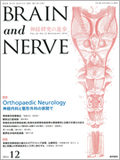Japanese
English
- 有料閲覧
- Abstract 文献概要
- 1ページ目 Look Inside
- 参考文献 Reference
脊髄性筋萎縮症はSMN1遺伝子欠失により発症し,α運動ニューロン変性を伴い進行性に筋力低下をきたす,乳児死亡で最多の遺伝子疾患である。分子病態としてRNAスプライシング障害が主に提唱されている。アンチセンスオリゴヌクレオチドを用いたSMN2スプライシング是正治療を含むSMN蛋白発現回復が有望な治療とされ,一方,近年末梢組織における病態が明らかになり,治療標的臓器が見直されてきている。
Abstract
Loss-of-function mutations in SMN1 cause spinal muscular atrophy (SMA), a leading genetic cause of infant mortality. Degeneration of alpha-motor neurons that results in progressive paralysis is a pathological hallmark of SMA. Recently, peripheral-tissue involvement has also been reported in SMA. Patients have low levels of functional SMN which is attributed to alternative splicing in SMN2, a gene closely-related to SMN1. This decrease in the expression of SMN, a ubiquitously expressed protein involved in promoting snRNP assembly required for splicing, is responsible for SMA. However, the mechanism through which decrease in SMN levels causes SMA remains unclear. Currently, no curative treatment is available for SMA, but SMN restoration is thought to be necessary and sufficient for cure. Antisense oligonucleotides (ASOs) can be designed to specifically alter splicing patterns of target pre-mRNAs. We identified an ASO that redirects SMN2 splicing and is currently in clinical trials for use as RNA-targeting therapeutics. Further, we have also reported a novel application of splicing-modulating ASOs——creation of animal phenocopy models of diseases by inducing mis-splicing. Exploring the relationship between the spatial and temporal effects of therapeutic and pathogenic ASOs yields relevant insights into the roles of SMN in SMA pathogenesis and into its normal physiological functions. This knowledge, in turn, contributes to the ongoing development of targeted therapeutics.

Copyright © 2014, Igaku-Shoin Ltd. All rights reserved.


